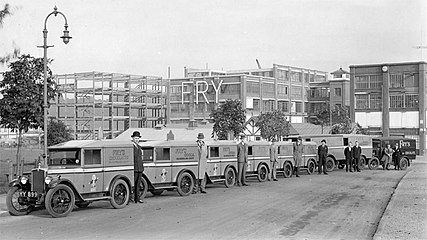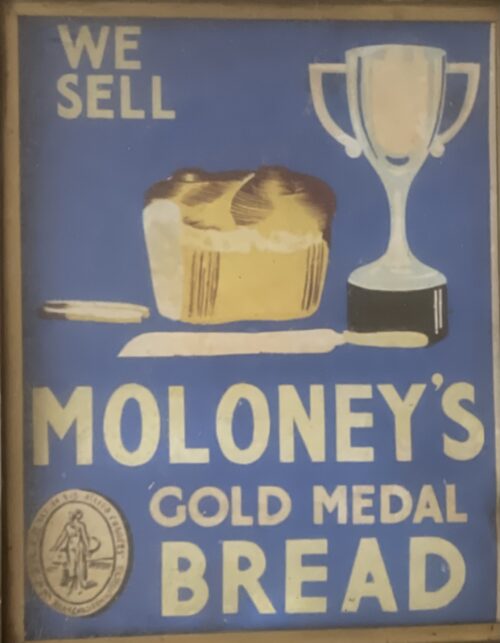-
 Cool retro ad from the 1970s with a bold and to the point message! Origins : Cork City Dimensions; 21cm x 32cm Glazed First produced in 1887, Wincarnis Tonic Wine is a natural tonic incorporating a unique infusion of herbs and spices. It’s also rich in vitamins, especially energy-giving Vitamin B complex. Usually enjoyed straight, Wincarnis Tonic Wine can also be mixed with gin to make a ‘Gin and Win’. Already a firm favourite in the United Kingdom, its export business continues to grow in Singapore, Malaysia, USA, West Indies and the UAE amongst many other markets.
Cool retro ad from the 1970s with a bold and to the point message! Origins : Cork City Dimensions; 21cm x 32cm Glazed First produced in 1887, Wincarnis Tonic Wine is a natural tonic incorporating a unique infusion of herbs and spices. It’s also rich in vitamins, especially energy-giving Vitamin B complex. Usually enjoyed straight, Wincarnis Tonic Wine can also be mixed with gin to make a ‘Gin and Win’. Already a firm favourite in the United Kingdom, its export business continues to grow in Singapore, Malaysia, USA, West Indies and the UAE amongst many other markets. -

 Fantastic vintage W.& R.Jacob & Co.Ltd Biscuit & Cake Manufacturers Dublin Advert depicting the famous Dublin Landmark which played such a pivotal role in the 1916 Easter Rising which altered the course of Irish History forever. Clonsilla Dublin 45.5cm x 57.5cm The biscuit making firm of W. & R. Jacob's were one the largest employers in the Dublin of 1916, and their factory was seized on Easter Monday by perhaps 100 members of the 2nd Battalion of the Dublin Brigade of the Irish Volunteers under Thomas MacDonagh. The factory itself was an enormous and formidable Victorian edifice located on the 'block' enclosed by Bishop St, Bride St, Peter's St and Peter's Row, and between St Patrick's Cathedral and St Stephen's Green. Its seizure helped to complete a loop of building cross the south inner city; the factory had two large towers that could act as observation points, while its location was very close to both Camden St and Patrick St: natural routeways for troops entering the city centre from Portobello Barracks in Rathmines and Wellington Barracks on the South Circular Road. There were only a few staff present in the building when the Volunteers broke into it; a number of smaller outposts were established in the area around the factory. While the garrison saw some fighting early in the week, their principal enemies proved to be boredom and the locals: the factory was surrounded by tenements, and the Volunteers were attacked and abused by residents, many of whom were Jacob's workers themselves. The families of servicemen were also quite hostile, but there may have been another reason for this hostility: Michael O'Hanrahan, who was in Jacob's, expressed his concern that the choice of location might endanger local residents if the British chose to attack. As it happens, the factory was largely by-passed, though it was fired upon intermittently throughout the week by troops in Dublin Castle and elsewhere. MacDonagh surrendered in nearby St Patrick's Park on Sunday 30 April; some of the factory was looted after the Volunteers had left. Three members of the Jacob's garrison were executed. Most of the factory was eventually demolished, though fragments of the ground storey and one of the towers are still visible on Bishop St between the DIT campus on Aungier St and the National Archives of Ireland.
Fantastic vintage W.& R.Jacob & Co.Ltd Biscuit & Cake Manufacturers Dublin Advert depicting the famous Dublin Landmark which played such a pivotal role in the 1916 Easter Rising which altered the course of Irish History forever. Clonsilla Dublin 45.5cm x 57.5cm The biscuit making firm of W. & R. Jacob's were one the largest employers in the Dublin of 1916, and their factory was seized on Easter Monday by perhaps 100 members of the 2nd Battalion of the Dublin Brigade of the Irish Volunteers under Thomas MacDonagh. The factory itself was an enormous and formidable Victorian edifice located on the 'block' enclosed by Bishop St, Bride St, Peter's St and Peter's Row, and between St Patrick's Cathedral and St Stephen's Green. Its seizure helped to complete a loop of building cross the south inner city; the factory had two large towers that could act as observation points, while its location was very close to both Camden St and Patrick St: natural routeways for troops entering the city centre from Portobello Barracks in Rathmines and Wellington Barracks on the South Circular Road. There were only a few staff present in the building when the Volunteers broke into it; a number of smaller outposts were established in the area around the factory. While the garrison saw some fighting early in the week, their principal enemies proved to be boredom and the locals: the factory was surrounded by tenements, and the Volunteers were attacked and abused by residents, many of whom were Jacob's workers themselves. The families of servicemen were also quite hostile, but there may have been another reason for this hostility: Michael O'Hanrahan, who was in Jacob's, expressed his concern that the choice of location might endanger local residents if the British chose to attack. As it happens, the factory was largely by-passed, though it was fired upon intermittently throughout the week by troops in Dublin Castle and elsewhere. MacDonagh surrendered in nearby St Patrick's Park on Sunday 30 April; some of the factory was looted after the Volunteers had left. Three members of the Jacob's garrison were executed. Most of the factory was eventually demolished, though fragments of the ground storey and one of the towers are still visible on Bishop St between the DIT campus on Aungier St and the National Archives of Ireland. -

 50cm x 70cm Drumcondra Dublin Once the Willy Wonka chocolate factory of Dublin,Williams & Woods kept generations of children and adults happy with their large range of confectionary items as advertised in this rare, original print from the late 1890s.The company is long gone but happily the building has been put to good use as you can read below.William's & Woods building on King's Inn Street in Dublin City Centre is where it all began - the first home to the Chocolate Factory shared creative space. Once manufacturing various sweet treats including Toblerone and Mint Crisp, this industrial building now houses an eclectic mix of small businesses and individuals in creative sectors including art, design, music, photography, craft, up-cycling, dance, illustration, graphics, events, horticulture, baking and small batch food & drink production. The incredible transformation and re-invention of Dublin's first concrete building into a creative and collaborative space continues in addition to other alternative Chocolate Factory venues around the country.
50cm x 70cm Drumcondra Dublin Once the Willy Wonka chocolate factory of Dublin,Williams & Woods kept generations of children and adults happy with their large range of confectionary items as advertised in this rare, original print from the late 1890s.The company is long gone but happily the building has been put to good use as you can read below.William's & Woods building on King's Inn Street in Dublin City Centre is where it all began - the first home to the Chocolate Factory shared creative space. Once manufacturing various sweet treats including Toblerone and Mint Crisp, this industrial building now houses an eclectic mix of small businesses and individuals in creative sectors including art, design, music, photography, craft, up-cycling, dance, illustration, graphics, events, horticulture, baking and small batch food & drink production. The incredible transformation and re-invention of Dublin's first concrete building into a creative and collaborative space continues in addition to other alternative Chocolate Factory venues around the country.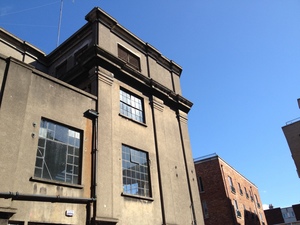
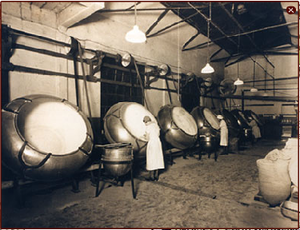
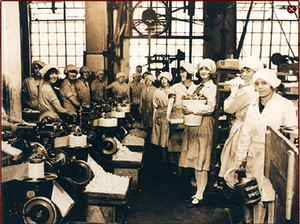
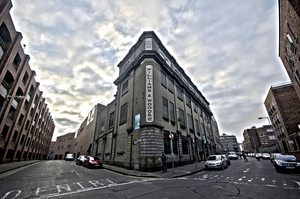 D
D
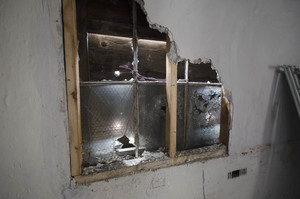
-
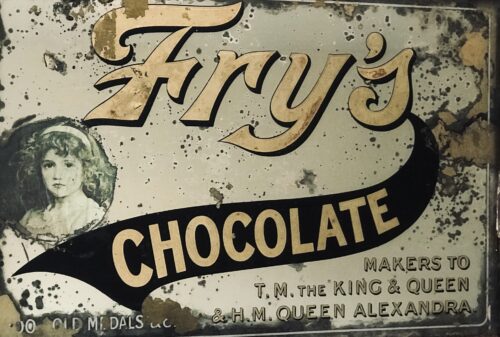
 Fantastic Frys Chocolate Advertising Mirror circa early 1900s. 40cm x 55cm Dublin S. Fry & Sons, Ltd. better known as Fry's, was a British chocolate company owned by Joseph Storrs Fry and his family. Beginning in Bristol in the 18th century, the business went through several changes of name and ownership, becoming J. S. Fry & Sons in 1822. In 1847, Fry's produced the first solid chocolate bar.[1][2] The company also created the first filled chocolate sweet, Cream Sticks, in 1853.[1] Fry is most famous for Fry's Chocolate Cream, the first mass-produced chocolate bar which was launched in 1866, and Fry's Turkish Delight, launched in 1914.[1] Fry, alongside Cadbury and Rowntree's, were the big three British confectionery manufacturers throughout much of the nineteenth and twentieth centuries.[3] The company became a division of Cadbury in the early twentieth century. The division's Somerdale Factory near Bristol was closed after the 2010 takeover of Cadbury's by Kraft Foods.
Fantastic Frys Chocolate Advertising Mirror circa early 1900s. 40cm x 55cm Dublin S. Fry & Sons, Ltd. better known as Fry's, was a British chocolate company owned by Joseph Storrs Fry and his family. Beginning in Bristol in the 18th century, the business went through several changes of name and ownership, becoming J. S. Fry & Sons in 1822. In 1847, Fry's produced the first solid chocolate bar.[1][2] The company also created the first filled chocolate sweet, Cream Sticks, in 1853.[1] Fry is most famous for Fry's Chocolate Cream, the first mass-produced chocolate bar which was launched in 1866, and Fry's Turkish Delight, launched in 1914.[1] Fry, alongside Cadbury and Rowntree's, were the big three British confectionery manufacturers throughout much of the nineteenth and twentieth centuries.[3] The company became a division of Cadbury in the early twentieth century. The division's Somerdale Factory near Bristol was closed after the 2010 takeover of Cadbury's by Kraft Foods.History[edit]
Joseph Fry, a Quaker, was born in 1728. He started making chocolate around 1759. In 1761 Joseph Fry and John Vaughan purchased a small shop from an apothecary, Walter Churchman, and with it the patent for a chocolate refining process.The company was then named Fry, Vaughan & Co.. In 1777 their chocolate works moved from Newgate Street to Union Street, Bristol. Joseph Fry died in 1787 and the company was renamed Anna Fry & Son. In 1795 Joseph Storrs Fryassumed control of the company. He patented a method of grinding cocoa beans using a Watt steam engine. As a result, factory techniques were introduced into the cocoa business. In 1803 Anna Fry died and Joseph Storrs Fry partnered with a Dr. Hunt. The business was renamed Fry & Hunt. In 1822 Hunt retired and Joseph Storrs Fry took on his sons Joseph, Francis and Richard as partners: the firm was renamed J. S. Fry & Sons. The company became the largest commercial producer of chocolate in the UK. In 1835 Joseph Storrs Fry died and his sons took full control. Tom Browne‘s advertisement postcard for Fry's chocolate, 1912In 1847, the Fry's chocolate factory, located in Union Street, Bristol, moulded a chocolate bar suitable for large-scale production.The firm began producing the Fry's Chocolate Cream bar in 1866.Over 220 products were introduced in the following decades, including production of the first chocolate Easter egg in UK in 1873 and the Fry's Turkish Delight (or Fry's Turkish bar) in 1914. In 1896 the firm became a registered private company. It was run by the Fry family, with Joseph Storrs Fry II, grandson of the first Joseph Storrs Fry, as the chairman. In 1881, an employee of Fry's H. J. Packer established his own chocolate business in Bristol. At its eventual home in Greenbank, Bristol, Packer's Chocolate continued to provide local competition for Fry's until 2006, under various owners and brands, from Bonds through to Famous Names and Elizabeth Shaw. Near the start of World War I the company was one of the largest employers in Bristol. Joseph Storrs Fry II died in 1913. By 1919 the company merged with Cadbury's chocolate and the joint company named British Cocoa and Chocolate Company. Under Egbert Cadbury the Fry's division began the move to Somerdale, Keynsham in 1923. After 1981 the name Fry's was no longer in use at Somerdale, but the factory was still a major producer of Cadbury's products. On 3 October 2007, Cadbury announced plans to close the Somerdale plant, the historic home of the Fry's Factory, by 2010 with the loss of some 500 jobs. In an effort to maintain competitiveness in a global marketplace, production was to be moved to a new factory in Poland. Another motivational factor was the high value of the land. Labour MP for Wansdyke, Dan Norris, said, "News of the factory's closure is a hard and heavy blow, not just to the workforce, but to the Keynsham community as a whole". In February 2010, following the takeover of Cadbury plc by Kraft Foods, the closure was controversially confirmed to take place in 2011; Kraft had specifically agreed during the takeover battle to keep the site open. There was widespread outrage in the press and later a House of Commons Select Committee investigation into the affair.Advertisement with the distinctive "five boys" design expressing "Desperation, Pacification, Expectation, Acclamation and Realization "It's Fry's". The reference to Queen Alexandra indicates a date before her death in 1925. Displayed in the Kirkcaldy Museum and Art Gallery
Tom Browne‘s advertisement postcard for Fry's chocolate, 1912In 1847, the Fry's chocolate factory, located in Union Street, Bristol, moulded a chocolate bar suitable for large-scale production.The firm began producing the Fry's Chocolate Cream bar in 1866.Over 220 products were introduced in the following decades, including production of the first chocolate Easter egg in UK in 1873 and the Fry's Turkish Delight (or Fry's Turkish bar) in 1914. In 1896 the firm became a registered private company. It was run by the Fry family, with Joseph Storrs Fry II, grandson of the first Joseph Storrs Fry, as the chairman. In 1881, an employee of Fry's H. J. Packer established his own chocolate business in Bristol. At its eventual home in Greenbank, Bristol, Packer's Chocolate continued to provide local competition for Fry's until 2006, under various owners and brands, from Bonds through to Famous Names and Elizabeth Shaw. Near the start of World War I the company was one of the largest employers in Bristol. Joseph Storrs Fry II died in 1913. By 1919 the company merged with Cadbury's chocolate and the joint company named British Cocoa and Chocolate Company. Under Egbert Cadbury the Fry's division began the move to Somerdale, Keynsham in 1923. After 1981 the name Fry's was no longer in use at Somerdale, but the factory was still a major producer of Cadbury's products. On 3 October 2007, Cadbury announced plans to close the Somerdale plant, the historic home of the Fry's Factory, by 2010 with the loss of some 500 jobs. In an effort to maintain competitiveness in a global marketplace, production was to be moved to a new factory in Poland. Another motivational factor was the high value of the land. Labour MP for Wansdyke, Dan Norris, said, "News of the factory's closure is a hard and heavy blow, not just to the workforce, but to the Keynsham community as a whole". In February 2010, following the takeover of Cadbury plc by Kraft Foods, the closure was controversially confirmed to take place in 2011; Kraft had specifically agreed during the takeover battle to keep the site open. There was widespread outrage in the press and later a House of Commons Select Committee investigation into the affair.Advertisement with the distinctive "five boys" design expressing "Desperation, Pacification, Expectation, Acclamation and Realization "It's Fry's". The reference to Queen Alexandra indicates a date before her death in 1925. Displayed in the Kirkcaldy Museum and Art GalleryArchives
Records relating to both the business and the family are held at Bristol Archives (Ref. 38538). Some records concerning the role of J. S. Fry & Sons within Cadbury are held with the Mondelez International repository at Cadbury's UK headquarters in Bournville.Popular culture
On the BBC television program Being Human, an old Fry's Cocoa billboard hangs prominently on the side of the B&B where the main characters reside in Series 3–5. The billboard is a nod to the show's original Bristol location. In April 2020 an original enamel advertising sign with the distinctive "five boys" trademark design was featured on BBC's Antiques Roadshow and was valued at £1,000-£1,500. The boy featured in the design, Lindsay Poulton, had been photographed in 1886 by his father who, for the first image, soaked a cloth in ammonia and wrapped it round the boy's neck to make him cry. Poulton, in his eighties, related this story to Fry's employees when he was given a tour of the Bristol factory.-
Somerdale Factory soon after opening
See also[edit]
-
-

 24cm x 40cm From the double-takes by people currently walking down King’s Inn Street at the doors to Williams and Woods , you might be forgiven for thinking the former confectionary factory is returning in some Willy Wonka spectacular. The building’s distinctive corner sign has snuck it into the city’s collective memory, making it deeply exciting to see boards coming away from the windows and the glazing being repaired. Williams and Woods moved to Great Britain Street (now Parnell Street) in 1875, operating as confectionary manufacturers and wholesalers. The company acquired adjacent sites, including land across Loftus Lane, and had a factory complex that produced sweets, preserves, canned goods and vinegar. (There’s a history of acquisitions – including being bought by Cross and Blackwell in 1928 – that’s a bit involved for our purposes, but it brings in many well-known names such as Chef, Toblerone, Keiller Little Chip, The National Canning Company of Ireland and Silvermints.) This particular part of the factory seems to have been built around 1900, completely destroyed by fire in 1908, and built again by 1910 (a jam factory designed by Donnelly & Moore), though it’s a little difficult to determine which part of the block is referred to in news reports.
24cm x 40cm From the double-takes by people currently walking down King’s Inn Street at the doors to Williams and Woods , you might be forgiven for thinking the former confectionary factory is returning in some Willy Wonka spectacular. The building’s distinctive corner sign has snuck it into the city’s collective memory, making it deeply exciting to see boards coming away from the windows and the glazing being repaired. Williams and Woods moved to Great Britain Street (now Parnell Street) in 1875, operating as confectionary manufacturers and wholesalers. The company acquired adjacent sites, including land across Loftus Lane, and had a factory complex that produced sweets, preserves, canned goods and vinegar. (There’s a history of acquisitions – including being bought by Cross and Blackwell in 1928 – that’s a bit involved for our purposes, but it brings in many well-known names such as Chef, Toblerone, Keiller Little Chip, The National Canning Company of Ireland and Silvermints.) This particular part of the factory seems to have been built around 1900, completely destroyed by fire in 1908, and built again by 1910 (a jam factory designed by Donnelly & Moore), though it’s a little difficult to determine which part of the block is referred to in news reports. -

 42cm x 32cm Limerick The Jacobs Biscuit Bakery originated in Waterford in 1851,after being founded by William Beale Jacob and his brother Robert.It later moved to Bishop Street in Dublin with a further factory in Peters Row.Jacobs Bishop Street premises was occupied as a strategic location by rebels during the 1916 Easter Rebellion. W. & R. Jacob's were one the largest employers in the Dublin of 1916, and their factory was seized on Easter Monday by perhaps 100 members of the 2nd Battalion of the Dublin Brigade of the Irish Volunteers under Thomas MacDonagh. The factory itself was an enormous and formidable Victorian edifice located on the 'block' enclosed by Bishop St, Bride St, Peter's St and Peter's Row, and between St Patrick's Cathedral and St Stephen's Green. Its seizure helped to complete a loop of building cross the south inner city; the factory had two large towers that could act as observation points, while its location was very close to both Camden St and Patrick St: natural routeways for troops entering the city centre from Portobello Barracks in Rathmines and Wellington Barracks on the South Circular Road. There were only a few staff present in the building when the Volunteers broke into it; a number of smaller outposts were established in the area around the factory. While the garrison saw some fighting early in the week, their principal enemies proved to be boredom and the locals: the factory was surrounded by tenements, and the Volunteers were attacked and abused by residents, many of whom were Jacob's workers themselves. The families of servicemen were also quite hostile, but there may have been another reason for this hostility: Michael O'Hanrahan, who was in Jacob's, expressed his concern that the choice of location might endanger local residents if the British chose to attack. As it happens, the factory was largely by-passed, though it was fired upon intermittently throughout the week by troops in Dublin Castle and elsewhere. MacDonagh surrendered in nearby St Patrick's Park on Sunday 30 April; some of the factory was looted after the Volunteers had left. Three members of the Jacob's garrison were executed. Most of the factory was eventually demolished, though fragments of the ground storey and one of the towers are still visible on Bishop St between the DIT campus on Aungier St and the National Archives of Ireland.
42cm x 32cm Limerick The Jacobs Biscuit Bakery originated in Waterford in 1851,after being founded by William Beale Jacob and his brother Robert.It later moved to Bishop Street in Dublin with a further factory in Peters Row.Jacobs Bishop Street premises was occupied as a strategic location by rebels during the 1916 Easter Rebellion. W. & R. Jacob's were one the largest employers in the Dublin of 1916, and their factory was seized on Easter Monday by perhaps 100 members of the 2nd Battalion of the Dublin Brigade of the Irish Volunteers under Thomas MacDonagh. The factory itself was an enormous and formidable Victorian edifice located on the 'block' enclosed by Bishop St, Bride St, Peter's St and Peter's Row, and between St Patrick's Cathedral and St Stephen's Green. Its seizure helped to complete a loop of building cross the south inner city; the factory had two large towers that could act as observation points, while its location was very close to both Camden St and Patrick St: natural routeways for troops entering the city centre from Portobello Barracks in Rathmines and Wellington Barracks on the South Circular Road. There were only a few staff present in the building when the Volunteers broke into it; a number of smaller outposts were established in the area around the factory. While the garrison saw some fighting early in the week, their principal enemies proved to be boredom and the locals: the factory was surrounded by tenements, and the Volunteers were attacked and abused by residents, many of whom were Jacob's workers themselves. The families of servicemen were also quite hostile, but there may have been another reason for this hostility: Michael O'Hanrahan, who was in Jacob's, expressed his concern that the choice of location might endanger local residents if the British chose to attack. As it happens, the factory was largely by-passed, though it was fired upon intermittently throughout the week by troops in Dublin Castle and elsewhere. MacDonagh surrendered in nearby St Patrick's Park on Sunday 30 April; some of the factory was looted after the Volunteers had left. Three members of the Jacob's garrison were executed. Most of the factory was eventually demolished, though fragments of the ground storey and one of the towers are still visible on Bishop St between the DIT campus on Aungier St and the National Archives of Ireland. -
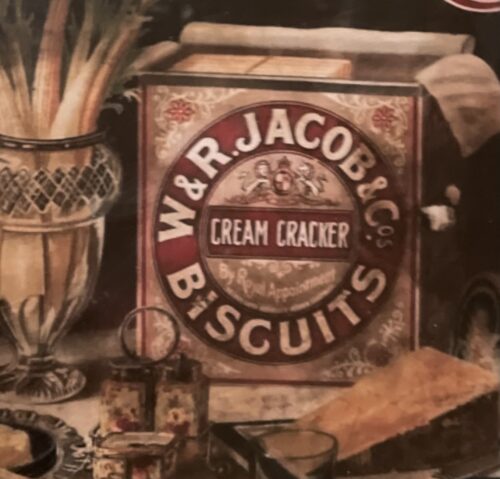
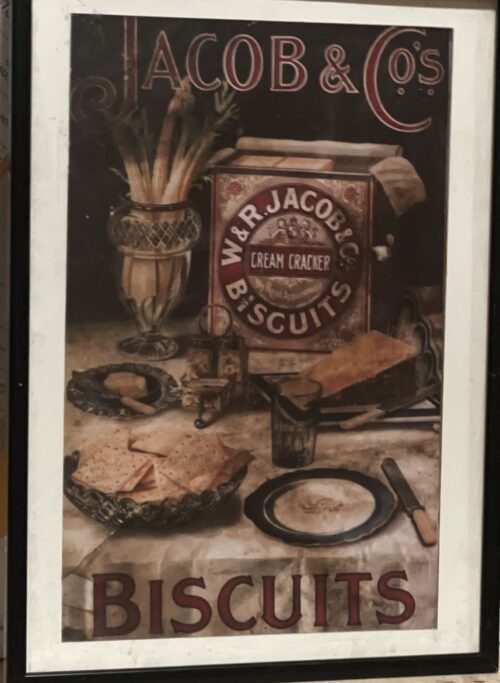 46cm x 39cm Limerick The Jacobs Biscuit Bakery originated in Waterford in 1851,after being founded by William Beale Jacob and his brother Robert.It later moved to Bishop Street in Dublin with a further factory in Peters Row.Jacobs Bishop Street premises was occupied as a strategic location by rebels during the 1916 Easter Rebellion. W. & R. Jacob's were one the largest employers in the Dublin of 1916, and their factory was seized on Easter Monday by perhaps 100 members of the 2nd Battalion of the Dublin Brigade of the Irish Volunteers under Thomas MacDonagh. The factory itself was an enormous and formidable Victorian edifice located on the 'block' enclosed by Bishop St, Bride St, Peter's St and Peter's Row, and between St Patrick's Cathedral and St Stephen's Green. Its seizure helped to complete a loop of building cross the south inner city; the factory had two large towers that could act as observation points, while its location was very close to both Camden St and Patrick St: natural routeways for troops entering the city centre from Portobello Barracks in Rathmines and Wellington Barracks on the South Circular Road. There were only a few staff present in the building when the Volunteers broke into it; a number of smaller outposts were established in the area around the factory. While the garrison saw some fighting early in the week, their principal enemies proved to be boredom and the locals: the factory was surrounded by tenements, and the Volunteers were attacked and abused by residents, many of whom were Jacob's workers themselves. The families of servicemen were also quite hostile, but there may have been another reason for this hostility: Michael O'Hanrahan, who was in Jacob's, expressed his concern that the choice of location might endanger local residents if the British chose to attack. As it happens, the factory was largely by-passed, though it was fired upon intermittently throughout the week by troops in Dublin Castle and elsewhere. MacDonagh surrendered in nearby St Patrick's Park on Sunday 30 April; some of the factory was looted after the Volunteers had left. Three members of the Jacob's garrison were executed. Most of the factory was eventually demolished, though fragments of the ground storey and one of the towers are still visible on Bishop St between the DIT campus on Aungier St and the National Archives of Ireland.
46cm x 39cm Limerick The Jacobs Biscuit Bakery originated in Waterford in 1851,after being founded by William Beale Jacob and his brother Robert.It later moved to Bishop Street in Dublin with a further factory in Peters Row.Jacobs Bishop Street premises was occupied as a strategic location by rebels during the 1916 Easter Rebellion. W. & R. Jacob's were one the largest employers in the Dublin of 1916, and their factory was seized on Easter Monday by perhaps 100 members of the 2nd Battalion of the Dublin Brigade of the Irish Volunteers under Thomas MacDonagh. The factory itself was an enormous and formidable Victorian edifice located on the 'block' enclosed by Bishop St, Bride St, Peter's St and Peter's Row, and between St Patrick's Cathedral and St Stephen's Green. Its seizure helped to complete a loop of building cross the south inner city; the factory had two large towers that could act as observation points, while its location was very close to both Camden St and Patrick St: natural routeways for troops entering the city centre from Portobello Barracks in Rathmines and Wellington Barracks on the South Circular Road. There were only a few staff present in the building when the Volunteers broke into it; a number of smaller outposts were established in the area around the factory. While the garrison saw some fighting early in the week, their principal enemies proved to be boredom and the locals: the factory was surrounded by tenements, and the Volunteers were attacked and abused by residents, many of whom were Jacob's workers themselves. The families of servicemen were also quite hostile, but there may have been another reason for this hostility: Michael O'Hanrahan, who was in Jacob's, expressed his concern that the choice of location might endanger local residents if the British chose to attack. As it happens, the factory was largely by-passed, though it was fired upon intermittently throughout the week by troops in Dublin Castle and elsewhere. MacDonagh surrendered in nearby St Patrick's Park on Sunday 30 April; some of the factory was looted after the Volunteers had left. Three members of the Jacob's garrison were executed. Most of the factory was eventually demolished, though fragments of the ground storey and one of the towers are still visible on Bishop St between the DIT campus on Aungier St and the National Archives of Ireland. -
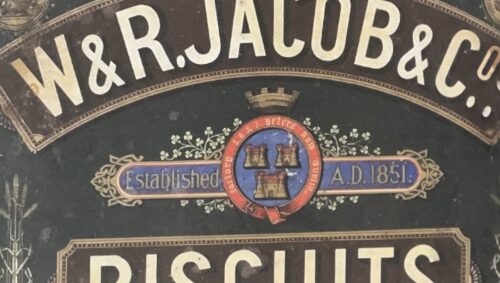
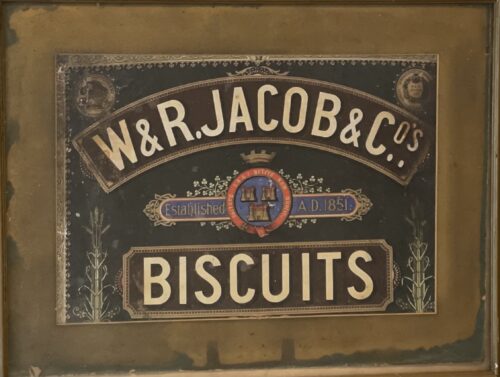 42cm x 32cm Limerick The Jacobs Biscuit Bakery originated in Waterford in 1851,after being founded by William Beale Jacob and his brother Robert.It later moved to Bishop Street in Dublin with a further factory in Peters Row.Jacobs Bishop Street premises was occupied as a strategic location by rebels during the 1916 Easter Rebellion. W. & R. Jacob's were one the largest employers in the Dublin of 1916, and their factory was seized on Easter Monday by perhaps 100 members of the 2nd Battalion of the Dublin Brigade of the Irish Volunteers under Thomas MacDonagh. The factory itself was an enormous and formidable Victorian edifice located on the 'block' enclosed by Bishop St, Bride St, Peter's St and Peter's Row, and between St Patrick's Cathedral and St Stephen's Green. Its seizure helped to complete a loop of building cross the south inner city; the factory had two large towers that could act as observation points, while its location was very close to both Camden St and Patrick St: natural routeways for troops entering the city centre from Portobello Barracks in Rathmines and Wellington Barracks on the South Circular Road. There were only a few staff present in the building when the Volunteers broke into it; a number of smaller outposts were established in the area around the factory. While the garrison saw some fighting early in the week, their principal enemies proved to be boredom and the locals: the factory was surrounded by tenements, and the Volunteers were attacked and abused by residents, many of whom were Jacob's workers themselves. The families of servicemen were also quite hostile, but there may have been another reason for this hostility: Michael O'Hanrahan, who was in Jacob's, expressed his concern that the choice of location might endanger local residents if the British chose to attack. As it happens, the factory was largely by-passed, though it was fired upon intermittently throughout the week by troops in Dublin Castle and elsewhere. MacDonagh surrendered in nearby St Patrick's Park on Sunday 30 April; some of the factory was looted after the Volunteers had left. Three members of the Jacob's garrison were executed. Most of the factory was eventually demolished, though fragments of the ground storey and one of the towers are still visible on Bishop St between the DIT campus on Aungier St and the National Archives of Ireland.
42cm x 32cm Limerick The Jacobs Biscuit Bakery originated in Waterford in 1851,after being founded by William Beale Jacob and his brother Robert.It later moved to Bishop Street in Dublin with a further factory in Peters Row.Jacobs Bishop Street premises was occupied as a strategic location by rebels during the 1916 Easter Rebellion. W. & R. Jacob's were one the largest employers in the Dublin of 1916, and their factory was seized on Easter Monday by perhaps 100 members of the 2nd Battalion of the Dublin Brigade of the Irish Volunteers under Thomas MacDonagh. The factory itself was an enormous and formidable Victorian edifice located on the 'block' enclosed by Bishop St, Bride St, Peter's St and Peter's Row, and between St Patrick's Cathedral and St Stephen's Green. Its seizure helped to complete a loop of building cross the south inner city; the factory had two large towers that could act as observation points, while its location was very close to both Camden St and Patrick St: natural routeways for troops entering the city centre from Portobello Barracks in Rathmines and Wellington Barracks on the South Circular Road. There were only a few staff present in the building when the Volunteers broke into it; a number of smaller outposts were established in the area around the factory. While the garrison saw some fighting early in the week, their principal enemies proved to be boredom and the locals: the factory was surrounded by tenements, and the Volunteers were attacked and abused by residents, many of whom were Jacob's workers themselves. The families of servicemen were also quite hostile, but there may have been another reason for this hostility: Michael O'Hanrahan, who was in Jacob's, expressed his concern that the choice of location might endanger local residents if the British chose to attack. As it happens, the factory was largely by-passed, though it was fired upon intermittently throughout the week by troops in Dublin Castle and elsewhere. MacDonagh surrendered in nearby St Patrick's Park on Sunday 30 April; some of the factory was looted after the Volunteers had left. Three members of the Jacob's garrison were executed. Most of the factory was eventually demolished, though fragments of the ground storey and one of the towers are still visible on Bishop St between the DIT campus on Aungier St and the National Archives of Ireland. -

 40cm x 34cm LimerickMuch of the last century, and indeed for well over half of the present one, Limerick's importance was directly attributed to her three well-known bacon factories, namely, J. Matterson & Sons, Roches Street, established in 1816 by Mr. John Russell, a Cumberland man in con-junction with Mr. Matterson, using the method of curing then current in Berwick-on-Tweed. W.J. Shaw & Sons, founded in the year 1831 at Mulgrave Street by William John Shaw, a descendant of a County Down family, and O'Mara's bacon factory, Roches Street, which had its origin in Mungret Street some few years before 1839, when James O'Mara from Toomevara started curing bacon in the basement of his house there. Apparently, this basement business flourished, for in 1839 he moved to Roches Street to the premises it last occupied .About the middle of the last century, for some reason now difficult to fathom, Limerick bacon and especially Limerick hams, became well-known for their excellent flavour throughout the English-speaking world. It is on record that Glasgow curers in an effort to produce hams equal in excellence to those of Limerick, imported Limerick workmen who were supposed to know all about the way in which the meat was turned out at home. Apparently, they did not bring secrets with them for their efforts were unsuccessful. There were also much larger bacon factories in parts of the British Isles; for instance, Belfast is reputed to have exported four times the number of hams produced in Limerick, and places like Glasgow and Liverpool had several factories producing very large quantities of bacon as well. None of them, however, quite matched' those produced in the three local factories for flavour and quality.O’MARA’S, MATTERSON’S, SHAW’S and Denny’s were the names that made Limerick famous for its bacon produce for 180 years – earning it the nickname ‘Pigstown’. The reputation of Limerick ham, the food culture that arose from a plentiful supply of cheap products, the story of the pork butchers, the pig buyers, the sounds of the city with factory horns signalling the call to work – all of these still resonate in Limerick in the memories of its citizens and former workers. A definitive account of this industry that operated at the centre of the city, supplied by the farms of rural county Limerick for over 180 years will be documented in a new book called Pigtown – A History of Limerick’s Bacon Industry. Ruth Guiry was commissioned to undertake the research under the guidance of Dr Maura Cronin from Mary Immaculate College and one of the 27 people she interviewed to understand the role the bacon factories had in Limerick was Joe Hayes. Joe Hayes started working in a bacon factory in 1962, aged 16 years old. He worked with his dad, and later on with his two sons until the factory closed in 1986. “When the factory closed, a group of us got our own little unit, we rented it, and produced our own sausages, puddings and things.” It was a huge part of Limerick’s social scene: four generations of Joe’s family worked in bacon factories, with uncles, sisters, brothers, sons and cousins all working in the factory at one time or another: “If one factory was caic, you wouldn’t have a problem getting a job in the other one. And he doesn’t mince his word when talking about the work they did. “They brought the pigs in, we killed the pigs, and prepared the bacon: that’s the way it was in the bacon factories.” When asked about if there were ever animal cruelty protests, he laughs at the idea.
40cm x 34cm LimerickMuch of the last century, and indeed for well over half of the present one, Limerick's importance was directly attributed to her three well-known bacon factories, namely, J. Matterson & Sons, Roches Street, established in 1816 by Mr. John Russell, a Cumberland man in con-junction with Mr. Matterson, using the method of curing then current in Berwick-on-Tweed. W.J. Shaw & Sons, founded in the year 1831 at Mulgrave Street by William John Shaw, a descendant of a County Down family, and O'Mara's bacon factory, Roches Street, which had its origin in Mungret Street some few years before 1839, when James O'Mara from Toomevara started curing bacon in the basement of his house there. Apparently, this basement business flourished, for in 1839 he moved to Roches Street to the premises it last occupied .About the middle of the last century, for some reason now difficult to fathom, Limerick bacon and especially Limerick hams, became well-known for their excellent flavour throughout the English-speaking world. It is on record that Glasgow curers in an effort to produce hams equal in excellence to those of Limerick, imported Limerick workmen who were supposed to know all about the way in which the meat was turned out at home. Apparently, they did not bring secrets with them for their efforts were unsuccessful. There were also much larger bacon factories in parts of the British Isles; for instance, Belfast is reputed to have exported four times the number of hams produced in Limerick, and places like Glasgow and Liverpool had several factories producing very large quantities of bacon as well. None of them, however, quite matched' those produced in the three local factories for flavour and quality.O’MARA’S, MATTERSON’S, SHAW’S and Denny’s were the names that made Limerick famous for its bacon produce for 180 years – earning it the nickname ‘Pigstown’. The reputation of Limerick ham, the food culture that arose from a plentiful supply of cheap products, the story of the pork butchers, the pig buyers, the sounds of the city with factory horns signalling the call to work – all of these still resonate in Limerick in the memories of its citizens and former workers. A definitive account of this industry that operated at the centre of the city, supplied by the farms of rural county Limerick for over 180 years will be documented in a new book called Pigtown – A History of Limerick’s Bacon Industry. Ruth Guiry was commissioned to undertake the research under the guidance of Dr Maura Cronin from Mary Immaculate College and one of the 27 people she interviewed to understand the role the bacon factories had in Limerick was Joe Hayes. Joe Hayes started working in a bacon factory in 1962, aged 16 years old. He worked with his dad, and later on with his two sons until the factory closed in 1986. “When the factory closed, a group of us got our own little unit, we rented it, and produced our own sausages, puddings and things.” It was a huge part of Limerick’s social scene: four generations of Joe’s family worked in bacon factories, with uncles, sisters, brothers, sons and cousins all working in the factory at one time or another: “If one factory was caic, you wouldn’t have a problem getting a job in the other one. And he doesn’t mince his word when talking about the work they did. “They brought the pigs in, we killed the pigs, and prepared the bacon: that’s the way it was in the bacon factories.” When asked about if there were ever animal cruelty protests, he laughs at the idea.
They started at 8am and finished at 5.30 working a 40 hour week when the factory closed in 1986, but despite their work, the people who worked in factories often couldn’t afford to buy the expensive cuts of meat. After the expensive cuts were prepared, the offal, the spare ribs, the pigs’ heads would go to the poorer people. “The blood was used to make the pudding, the packet, the tripe was made off the belly. Everything was used off the pig, and it fed Limerick city.” It was a way of life down in Limerick, so when the factories closed, thousands of people working in a bacon factories were out of jobs, and thousands of families were affected. But it wasn’t the competition from big supermarkets that did it – it was free trade. The Danes, the French, the Dutch all started exporting their products here, and Limerick factories didn’t have the money to export to compete. “Michael O’Mara’s funeral was this week – he was the last of the bacon factory managers.” says Joe. “After the Limerick factory closed, he tried doing different bits and pieces, but nothing worked out for him, so he worked in a factory for a couple of years before retiring.” Joe Hayes himself is retired now, and when he buys his meat he gets it in a supermarket. “Meat is meat,” he says.”But if I see the tricolour flag, I’ll still buy it even if it’s dearer.” Pigtown - A History of Limerick’s Bacon Industry by Ruth Guiry is co-edited by Dr Maura Cronin and Jacqui Hayes.People still eat sausages and bacon – where do they think they come from? -

 47cm x 37cm LimerickFor much of the last century, and indeed for well over half of the present one, Limerick's importance was directly attributed to her three well-known bacon factories, namely, J. Matterson & Sons, Roches Street, established in 1816 by Mr. John Russell, a Cumberland man in conjunction with Mr. Matterson, using the method of curing then current in Berwick-on-Tweed. W.J. Shaw & Sons, founded in the year 1831 at Mulgrave Street by William John Shaw, a descendant of a County Down family, and O'Mara's bacon factory, Roches Street, which had its origin in Mungret Street some few years before 1839, when James O'Mara from Toomevara started curing bacon in the basement of his house there. Apparently, this basement business flourished, for in 1839 he moved to Roches Street to the premises it occupies today.About the middle of the last century, for some reason now difficult to fathom, Limerick bacon and especially Limerick hams, became well known for their excellent flavour throughout the English-speaking world. It is on record that Glasgow curers in an effort to produce hams equal in excellence to those of Limerick, imported Limerick workmen who were supposed to know all about the way in which the meat was turned out at home. Apparently, they did not bring secrets with them for their efforts were unsuccessful, There were also much larger bacon factories in parts of the British Isles; for instance, Belfast is reputed to have exported four times the number of hams produced in Limerick, and places like Glasgow and Liverpool had several factories producing very large quantities of bacon as well. None of them, however, quite matched' those produced in the three local factories for flavour and taste. O’MARA’S, MATTERSON’S, SHAW’S and Denny’s were the names that made Limerick famous for its bacon produce for 180 years – earning it the nickname ‘Pigstown’. The reputation of Limerick ham, the food culture that arose from a plentiful supply of cheap products, the story of the pork butchers, the pig buyers, the sounds of the city with factory horns signalling the call to work – all of these still resonate in Limerick in the memories of its citizens and former workers. A definitive account of this industry that operated at the centre of the city, supplied by the farms of rural county Limerick for over 180 years will be documented in a new book called Pigtown – A History of Limerick’s Bacon Industry. Ruth Guiry was commissioned to undertake the research under the guidance of Dr Maura Cronin from Mary Immaculate College and one of the 27 people she interviewed to understand the role the bacon factories had in Limerick was Joe Hayes. Joe Hayes started working in a bacon factory in 1962, aged 16 years old. He worked with his dad, and later on with his two sons until the factory closed in 1986. “When the factory closed, a group of us got our own little unit, we rented it, and produced our own sausages, puddings and things.” It was a huge part of Limerick’s social scene: four generations of Joe’s family worked in bacon factories, with uncles, sisters, brothers, sons and cousins all working in the factory at one time or another: “If one factory was caic, you wouldn’t have a problem getting a job in the other one. And he doesn’t mince his word when talking about the work they did. “They brought the pigs in, we killed the pigs, and prepared the bacon: that’s the way it was in the bacon factories.” When asked about if there were ever animal cruelty protests, he laughs at the idea.
47cm x 37cm LimerickFor much of the last century, and indeed for well over half of the present one, Limerick's importance was directly attributed to her three well-known bacon factories, namely, J. Matterson & Sons, Roches Street, established in 1816 by Mr. John Russell, a Cumberland man in conjunction with Mr. Matterson, using the method of curing then current in Berwick-on-Tweed. W.J. Shaw & Sons, founded in the year 1831 at Mulgrave Street by William John Shaw, a descendant of a County Down family, and O'Mara's bacon factory, Roches Street, which had its origin in Mungret Street some few years before 1839, when James O'Mara from Toomevara started curing bacon in the basement of his house there. Apparently, this basement business flourished, for in 1839 he moved to Roches Street to the premises it occupies today.About the middle of the last century, for some reason now difficult to fathom, Limerick bacon and especially Limerick hams, became well known for their excellent flavour throughout the English-speaking world. It is on record that Glasgow curers in an effort to produce hams equal in excellence to those of Limerick, imported Limerick workmen who were supposed to know all about the way in which the meat was turned out at home. Apparently, they did not bring secrets with them for their efforts were unsuccessful, There were also much larger bacon factories in parts of the British Isles; for instance, Belfast is reputed to have exported four times the number of hams produced in Limerick, and places like Glasgow and Liverpool had several factories producing very large quantities of bacon as well. None of them, however, quite matched' those produced in the three local factories for flavour and taste. O’MARA’S, MATTERSON’S, SHAW’S and Denny’s were the names that made Limerick famous for its bacon produce for 180 years – earning it the nickname ‘Pigstown’. The reputation of Limerick ham, the food culture that arose from a plentiful supply of cheap products, the story of the pork butchers, the pig buyers, the sounds of the city with factory horns signalling the call to work – all of these still resonate in Limerick in the memories of its citizens and former workers. A definitive account of this industry that operated at the centre of the city, supplied by the farms of rural county Limerick for over 180 years will be documented in a new book called Pigtown – A History of Limerick’s Bacon Industry. Ruth Guiry was commissioned to undertake the research under the guidance of Dr Maura Cronin from Mary Immaculate College and one of the 27 people she interviewed to understand the role the bacon factories had in Limerick was Joe Hayes. Joe Hayes started working in a bacon factory in 1962, aged 16 years old. He worked with his dad, and later on with his two sons until the factory closed in 1986. “When the factory closed, a group of us got our own little unit, we rented it, and produced our own sausages, puddings and things.” It was a huge part of Limerick’s social scene: four generations of Joe’s family worked in bacon factories, with uncles, sisters, brothers, sons and cousins all working in the factory at one time or another: “If one factory was caic, you wouldn’t have a problem getting a job in the other one. And he doesn’t mince his word when talking about the work they did. “They brought the pigs in, we killed the pigs, and prepared the bacon: that’s the way it was in the bacon factories.” When asked about if there were ever animal cruelty protests, he laughs at the idea.
They started at 8am and finished at 5.30 working a 40 hour week when the factory closed in 1986, but despite their work, the people who worked in factories often couldn’t afford to buy the expensive cuts of meat. After the expensive cuts were prepared, the offal, the spare ribs, the pigs’ heads would go to the poorer people. “The blood was used to make the pudding, the packet, the tripe was made off the belly. Everything was used off the pig, and it fed Limerick city.” It was a way of life down in Limerick, so when the factories closed, thousands of people working in a bacon factories were out of jobs, and thousands of families were affected. But it wasn’t the competition from big supermarkets that did it – it was free trade. The Danes, the French, the Dutch all started exporting their products here, and Limerick factories didn’t have the money to export to compete. “Michael O’Mara’s funeral was this week – he was the last of the bacon factory managers.” says Joe. “After the Limerick factory closed, he tried doing different bits and pieces, but nothing worked out for him, so he worked in a factory for a couple of years before retiring.” Joe Hayes himself is retired now, and when he buys his meat he gets it in a supermarket. “Meat is meat,” he says.”But if I see the tricolour flag, I’ll still buy it even if it’s dearer.” Pigtown - A History of Limerick’s Bacon Industry by Ruth Guiry is co-edited by Dr Maura Cronin and Jacqui Hayes.People still eat sausages and bacon – where do they think they come from? -

 47cm x 37cm LimerickMuch of the last century, and indeed for well over half of the present one, Limerick's importance was directly attributed to her three well-known bacon factories, namely, J. Matterson & Sons, Roches Street, established in 1816 by Mr. John Russell, a Cumberland man in con-junction with Mr. Matterson, using the method of curing then current in Berwick-on-Tweed. W.J. Shaw & Sons, founded in the year 1831 at Mulgrave Street by William John Shaw, a descendant of a County Down family, and O'Mara's bacon factory, Roches Street, which had its origin in Mungret Street some few years before 1839, when James O'Mara from Toomevara started curing bacon in the basement of his house there. Apparently, this basement business flourished, for in 1839 he moved to Roches Street to the premises it last occupied .About the middle of the last century, for some reason now difficult to fathom, Limerick bacon and especially Limerick hams, became well-known for their excellent flavour throughout the English-speaking world. It is on record that Glasgow curers in an effort to produce hams equal in excellence to those of Limerick, imported Limerick workmen who were supposed to know all about the way in which the meat was turned out at home. Apparently, they did not bring secrets with them for their efforts were unsuccessful. There were also much larger bacon factories in parts of the British Isles; for instance, Belfast is reputed to have exported four times the number of hams produced in Limerick, and places like Glasgow and Liverpool had several factories producing very large quantities of bacon as well. None of them, however, quite matched' those produced in the three local factories for flavour and quality.O’MARA’S, MATTERSON’S, SHAW’S and Denny’s were the names that made Limerick famous for its bacon produce for 180 years – earning it the nickname ‘Pigstown’. The reputation of Limerick ham, the food culture that arose from a plentiful supply of cheap products, the story of the pork butchers, the pig buyers, the sounds of the city with factory horns signalling the call to work – all of these still resonate in Limerick in the memories of its citizens and former workers. A definitive account of this industry that operated at the centre of the city, supplied by the farms of rural county Limerick for over 180 years will be documented in a new book called Pigtown – A History of Limerick’s Bacon Industry. Ruth Guiry was commissioned to undertake the research under the guidance of Dr Maura Cronin from Mary Immaculate College and one of the 27 people she interviewed to understand the role the bacon factories had in Limerick was Joe Hayes. Joe Hayes started working in a bacon factory in 1962, aged 16 years old. He worked with his dad, and later on with his two sons until the factory closed in 1986. “When the factory closed, a group of us got our own little unit, we rented it, and produced our own sausages, puddings and things.” It was a huge part of Limerick’s social scene: four generations of Joe’s family worked in bacon factories, with uncles, sisters, brothers, sons and cousins all working in the factory at one time or another: “If one factory was caic, you wouldn’t have a problem getting a job in the other one. And he doesn’t mince his word when talking about the work they did. “They brought the pigs in, we killed the pigs, and prepared the bacon: that’s the way it was in the bacon factories.” When asked about if there were ever animal cruelty protests, he laughs at the idea.
47cm x 37cm LimerickMuch of the last century, and indeed for well over half of the present one, Limerick's importance was directly attributed to her three well-known bacon factories, namely, J. Matterson & Sons, Roches Street, established in 1816 by Mr. John Russell, a Cumberland man in con-junction with Mr. Matterson, using the method of curing then current in Berwick-on-Tweed. W.J. Shaw & Sons, founded in the year 1831 at Mulgrave Street by William John Shaw, a descendant of a County Down family, and O'Mara's bacon factory, Roches Street, which had its origin in Mungret Street some few years before 1839, when James O'Mara from Toomevara started curing bacon in the basement of his house there. Apparently, this basement business flourished, for in 1839 he moved to Roches Street to the premises it last occupied .About the middle of the last century, for some reason now difficult to fathom, Limerick bacon and especially Limerick hams, became well-known for their excellent flavour throughout the English-speaking world. It is on record that Glasgow curers in an effort to produce hams equal in excellence to those of Limerick, imported Limerick workmen who were supposed to know all about the way in which the meat was turned out at home. Apparently, they did not bring secrets with them for their efforts were unsuccessful. There were also much larger bacon factories in parts of the British Isles; for instance, Belfast is reputed to have exported four times the number of hams produced in Limerick, and places like Glasgow and Liverpool had several factories producing very large quantities of bacon as well. None of them, however, quite matched' those produced in the three local factories for flavour and quality.O’MARA’S, MATTERSON’S, SHAW’S and Denny’s were the names that made Limerick famous for its bacon produce for 180 years – earning it the nickname ‘Pigstown’. The reputation of Limerick ham, the food culture that arose from a plentiful supply of cheap products, the story of the pork butchers, the pig buyers, the sounds of the city with factory horns signalling the call to work – all of these still resonate in Limerick in the memories of its citizens and former workers. A definitive account of this industry that operated at the centre of the city, supplied by the farms of rural county Limerick for over 180 years will be documented in a new book called Pigtown – A History of Limerick’s Bacon Industry. Ruth Guiry was commissioned to undertake the research under the guidance of Dr Maura Cronin from Mary Immaculate College and one of the 27 people she interviewed to understand the role the bacon factories had in Limerick was Joe Hayes. Joe Hayes started working in a bacon factory in 1962, aged 16 years old. He worked with his dad, and later on with his two sons until the factory closed in 1986. “When the factory closed, a group of us got our own little unit, we rented it, and produced our own sausages, puddings and things.” It was a huge part of Limerick’s social scene: four generations of Joe’s family worked in bacon factories, with uncles, sisters, brothers, sons and cousins all working in the factory at one time or another: “If one factory was caic, you wouldn’t have a problem getting a job in the other one. And he doesn’t mince his word when talking about the work they did. “They brought the pigs in, we killed the pigs, and prepared the bacon: that’s the way it was in the bacon factories.” When asked about if there were ever animal cruelty protests, he laughs at the idea.
They started at 8am and finished at 5.30 working a 40 hour week when the factory closed in 1986, but despite their work, the people who worked in factories often couldn’t afford to buy the expensive cuts of meat. After the expensive cuts were prepared, the offal, the spare ribs, the pigs’ heads would go to the poorer people. “The blood was used to make the pudding, the packet, the tripe was made off the belly. Everything was used off the pig, and it fed Limerick city.” It was a way of life down in Limerick, so when the factories closed, thousands of people working in a bacon factories were out of jobs, and thousands of families were affected. But it wasn’t the competition from big supermarkets that did it – it was free trade. The Danes, the French, the Dutch all started exporting their products here, and Limerick factories didn’t have the money to export to compete. “Michael O’Mara’s funeral was this week – he was the last of the bacon factory managers.” says Joe. “After the Limerick factory closed, he tried doing different bits and pieces, but nothing worked out for him, so he worked in a factory for a couple of years before retiring.” Joe Hayes himself is retired now, and when he buys his meat he gets it in a supermarket. “Meat is meat,” he says.”But if I see the tricolour flag, I’ll still buy it even if it’s dearer.” Pigtown - A History of Limerick’s Bacon Industry by Ruth Guiry is co-edited by Dr Maura Cronin and Jacqui Hayes.People still eat sausages and bacon – where do they think they come from?












